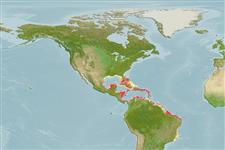Common names from other countries
Environment: milieu / climate zone / depth range / distribution range
экология
. Tropical
Western Atlantic.
Length at first maturity / Size / Вес / Возраст
Maturity: Lm ? range ? - ? cmCommon length : 9.8 cm TL самец/пол неопределен; (Ref. 344)
Shell subcircular, heavy, inequivalve. Shell surface smooth except for fine, irregular growth lines. Hinge well developed, with posterior lateral tooth long and strong. Pallial sinus large, well developed. Umbones at central part of dorsal region. Oblique ridge runs from umbo to middle of posterior margin. Posterior shell margin sinuous in posterior view: posterior margin of right valve concave and of left valve concave. Colour: externally white, internally glossier white with yellow tinges.
In shallow water, deeply burrowing in intertidal sand near seagrass beds (Ref. 344).
Life cycle and mating behavior
половая зрелость | размножение | нерест | икра | Fecundity | личинки
Members of the class Bivalvia are mostly gonochoric, some are protandric hermaphrodites. Life cycle: Embryos develop into free-swimming trocophore larvae, succeeded by the bivalve veliger, resembling a miniature clam.
Основная ссылка
ссылки | координатор | соавторы
Leal, J.H. 2003. (Ref. 344)
Статус Красного Списка МСОП (Ref. 130435)
Статус СИТЕС (Ref. 108899)
Not Evaluated
Not Evaluated
Использование человеком
рыболовство: коммерческий
| FishSource |
инструменты
дополнительная информация
Возраст/РазмерыростЗависимость между длиной и массой телаЗависимость между длинамиморфологияличинкичисленность
ресурсы в Интернет
Estimates based on models
Категория цены
Unknown.
